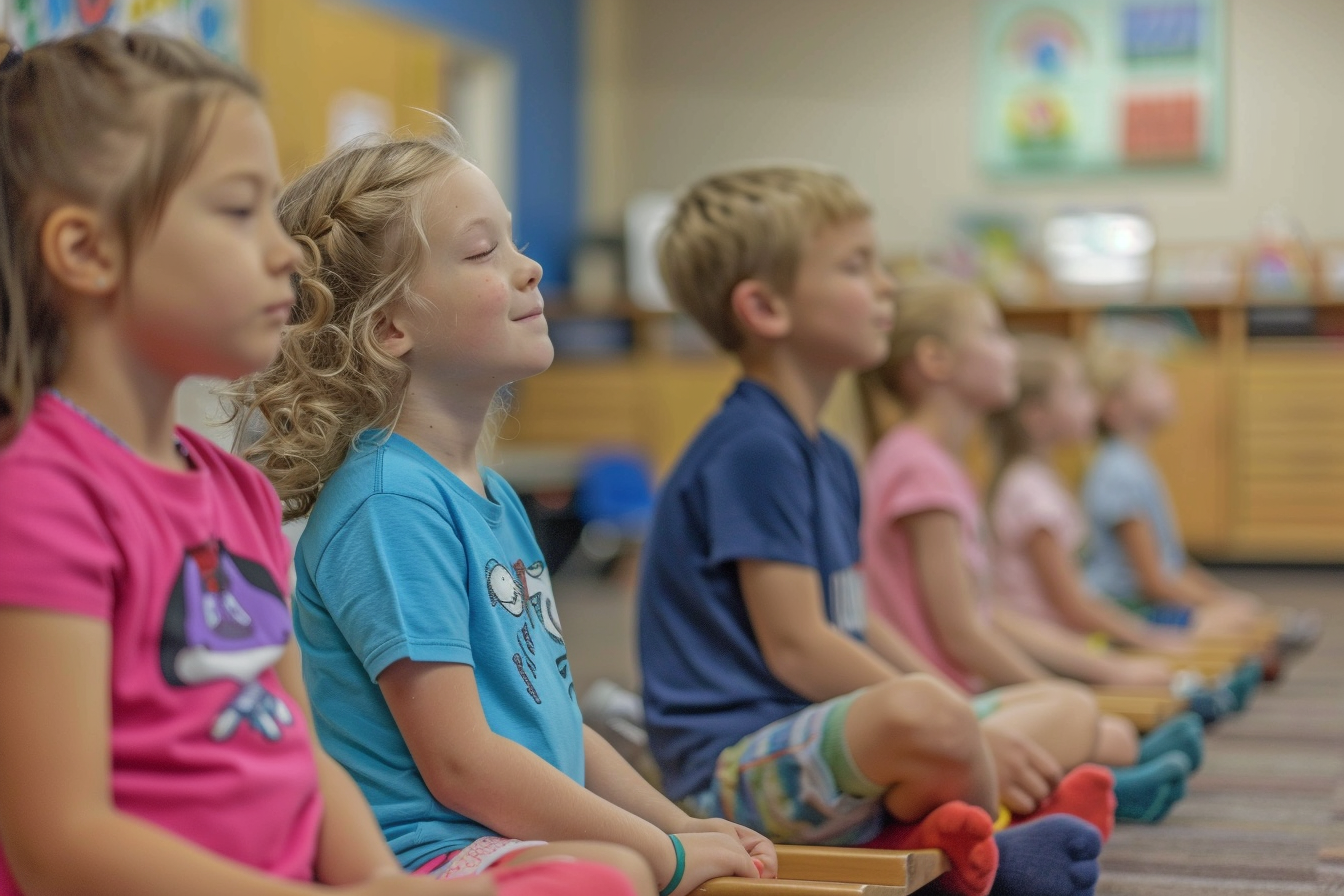Teaching Mindfulness in Schools: Boosting Emotional Resilience and Wellbeing
Teach mindfulness in schools to strengthen students' emotional resilience, focus, and wellbeing while creating calmer, more effective classrooms.

Imagine a classroom where students are not only academically engaged but also emotionally resilient, equipped to handle the stresses of daily life with calm and focus. This vision is becoming a reality in schools that integrate mindfulness practices into their curriculum. By teaching students mindfulness techniques, educators can foster an environment of emotional wellbeing and enhance students' overall learning experience.
In today’s fast-paced world, the need for emotional resilience and mental health support has never been greater. Mindfulness offers a practical solution, helping students develop skills to manage stress, improve concentration, and navigate their emotions effectively. Integrating mindfulness into education not only supports academic success but also promotes a healthier, more balanced lifestyle for students.
We will explore the principles, benefits, and implementation strategies of incorporating mindfulness in schools. We will delve into various mindfulness practices, highlight the advantages for both students and teachers, and provide practical tips for successfully integrating mindfulness into the curriculum. Join us as we uncover how mindfulness can transform the educational landscape and enhance emotional resilience and wellbeing for all students.
Understanding Mindfulness in Education
Mindfulness in education involves incorporating mindfulness practices into the classroom to enhance students' emotional resilience and overall wellbeing. Mindfulness is the practice of being present and fully engaged in the current moment, with a non-judgmental awareness of thoughts, emotions, and surroundings. In an educational setting, mindfulness helps students manage stress, improve focus, and develop emotional regulation skills.
Enjoy science fiction? Check out my space books HERE on Amazon!
The rise of mindfulness practices in schools reflects a growing recognition of their benefits for student wellbeing. Initially, mindfulness was introduced in educational settings as a way to help students cope with stress and anxiety. Over time, it has gained popularity and become integrated into various aspects of the curriculum, from daily classroom routines to specific mindfulness programs. Core principles of mindfulness in education include presence, awareness, and emotional regulation. By fostering these skills, schools aim to create a supportive learning environment that promotes both academic and personal growth.
Types of Mindfulness Practices in the Classroom
Incorporating mindfulness into the classroom can take many forms, each offering unique benefits for students. Here are some common types of mindfulness practices:
- Mindful Breathing Exercises: These techniques help students focus and calm their minds. Simple breathing exercises can be integrated into the start of the school day or used before tests and other stressful activities.
- Guided Meditation: Short sessions of guided meditation can enhance relaxation and focus. These sessions typically involve a teacher or recording guiding students through a series of calming visualizations and reflections.
- Mindful Movement: Activities such as yoga or tai chi promote physical and mental wellbeing. Incorporating mindful movement into physical education classes or as a break during the school day helps students connect with their bodies and reduce stress.
- Gratitude Journaling: Encouraging students to reflect on positive experiences through gratitude journaling fosters a positive mindset. Students can regularly write about things they are grateful for, which can enhance their overall wellbeing.
- Mindful Listening and Communication: Activities that promote active listening and empathetic communication help students build stronger interpersonal relationships. These exercises can be used in group discussions or partner activities to improve social skills and emotional intelligence.
By exploring these types of mindfulness practices, educators can find methods that best suit their classroom environment and student needs.
Benefits of Mindfulness in Education
Mindfulness practices offer numerous advantages, making them a valuable addition to the educational curriculum. Here are some key benefits:
- Improved Focus and Concentration: Mindfulness helps students stay present and attentive in class, enhancing their ability to concentrate on their studies.
- Enhanced Emotional Regulation: Teaching students to manage their emotions effectively can lead to better coping strategies and reduced instances of emotional outbursts.
- Reduced Stress and Anxiety: Mindfulness provides tools to cope with academic and personal pressures, helping students manage stress and anxiety more effectively.
- Better Classroom Behavior: Promoting a calm and respectful learning environment through mindfulness practices can lead to improved behavior and fewer disruptions.
- Increased Empathy and Social Skills: Mindfulness fosters stronger interpersonal relationships by teaching students empathy and effective communication skills.
These benefits highlight the potential of mindfulness to create a more supportive and effective educational environment. By understanding these advantages, educators and administrators can better appreciate the value of integrating mindfulness practices into their schools.
Implementing Mindfulness in the Curriculum
Implementing mindfulness in the curriculum requires careful planning and collaboration. The first step is developing a structured approach to integrating mindfulness practices. This includes defining goals, identifying target areas within the curriculum, and outlining specific mindfulness activities to be included.
Teacher training and professional development are crucial. Ensuring that educators are equipped to teach mindfulness and integrate it into their classrooms is essential for the program's success. Providing ongoing training and resources helps teachers feel confident and supported in their efforts.
Curriculum integration involves incorporating mindfulness activities into daily routines and subjects. This can be done through designated mindfulness periods, integrating mindfulness into existing subjects, or using mindfulness techniques during transitions and breaks.
Student involvement is key. Encouraging students to participate actively in mindfulness activities and providing opportunities for feedback helps ensure that the practices are engaging and effective. Involving students in the planning process can also foster a sense of ownership and commitment to mindfulness practices.
Assessment and evaluation are important for measuring the impact of mindfulness practices on student wellbeing. Regularly assessing the effectiveness of the activities and making necessary adjustments ensures that the program continues to meet its goals and benefits students.
By following these steps, schools can successfully implement mindfulness practices that enhance emotional resilience and overall wellbeing.
Overcoming Challenges in Teaching Mindfulness
Implementing mindfulness in the curriculum comes with its own set of challenges, but these can be effectively managed with strategic planning and collaboration. One major challenge is teacher resistance. Addressing concerns and building buy-in among educators requires clear communication about the benefits of mindfulness and involving teachers in the planning process.
Student engagement is another challenge. Ensuring mindfulness activities are age-appropriate and engaging helps maintain student interest and participation. Tailoring activities to different age groups and incorporating a variety of techniques can enhance engagement.
Time constraints can also be a barrier. Finding time within the school schedule for mindfulness practices requires careful planning and prioritization. Integrating short mindfulness activities into existing routines and subjects can help manage this challenge.
Sustaining practice is crucial for long-term success. Maintaining consistent and ongoing mindfulness activities helps embed these practices into the school culture and maximize their impact.
By addressing these challenges, schools can create a supportive and effective environment for teaching mindfulness.
Case Studies
Implementing mindfulness in schools has led to notable successes in various educational settings across the country. Here are three case studies highlighting the impact of these methods:
Case Study 1: Mindfulness Program in an Illinois Elementary School
An elementary school in Illinois introduced a mindfulness program that included daily breathing exercises and weekly guided meditation sessions. Teachers reported improved student focus and a decrease in behavioral issues. Students expressed that they felt calmer and more equipped to handle stress.
Case Study 2: Implementing Mindful Movement in a Florida Middle School
A middle school in Florida incorporated mindful movement activities, such as yoga and tai chi, into their physical education curriculum. The program led to increased student engagement in PE classes and improved physical and mental wellbeing. Students appreciated the opportunity to participate in activities that helped them relax and focus.
Case Study 3: Guided Meditation in a Colorado High School
A high school in Colorado implemented guided meditation sessions during advisory periods. The sessions were designed to help students manage academic stress and improve concentration. Teachers observed that students were more attentive and less anxious during classes. The program also received positive feedback from parents who noticed improvements in their children's overall demeanor.
Practical Tips for Educators and Administrators
Implementing mindfulness in the curriculum can be straightforward with the right approach. Here are some practical tips for educators and administrators to consider:
- Start Small: Begin with short, simple mindfulness activities to introduce the concept to students and teachers gradually.
- Create a Supportive Environment: Foster a classroom culture that embraces mindfulness by modeling mindful behavior and encouraging open discussions about its benefits.
- Use Varied Techniques: Incorporate different mindfulness practices, such as breathing exercises, guided meditation, and mindful movement, to keep students engaged and interested.
- Seek Student Feedback: Regularly check in with students about their mindfulness experiences and make adjustments based on their feedback to ensure the practices remain effective and relevant.
- Promote Consistency: Integrate mindfulness into the daily routine to help students develop a regular practice and experience the long-term benefits.
These tips can help educators and administrators create a successful and sustainable mindfulness program that enhances emotional resilience and wellbeing.
Future Trends in Mindfulness in Education
The future of mindfulness in education is evolving, with new trends enhancing its effectiveness and reach. Digital mindfulness tools, such as apps and online resources, are becoming increasingly popular. These tools provide accessible and convenient ways for students and teachers to practice mindfulness regularly.
Integration with social-emotional learning (SEL) programs is another emerging trend. Combining mindfulness with SEL curricula helps create a comprehensive approach to student wellbeing, addressing both emotional and social skills.
Check out our engaging printable posters. CLICK HERE to explore!
Focusing on teacher wellbeing is also gaining importance. Supporting teachers’ mindfulness practice can enhance their ability to teach mindfulness effectively and contribute to a positive school culture.
Research and evidence-based practices are becoming more prevalent. Leveraging scientific research to inform mindfulness practices ensures that the activities are effective and based on proven methods.
Global perspectives are also influencing the field. Learning from mindfulness initiatives and successes worldwide can provide new insights and approaches to integrating mindfulness in education.
By staying updated with these trends, schools can continue to innovate and provide high-quality mindfulness education for students.
Conclusion
Integrating mindfulness into the curriculum offers a powerful approach to enhancing students' emotional resilience and overall wellbeing. By incorporating practices such as mindful breathing, guided meditation, and mindful movement, schools can create a supportive learning environment that helps students manage stress, improve focus, and develop essential emotional regulation skills.
As education continues to evolve, it is crucial for schools to adopt innovative strategies that support both academic and personal growth. Overcoming challenges such as teacher resistance, student engagement, and time constraints requires careful planning and collaboration. By embracing future trends like digital mindfulness tools and integrating mindfulness with social-emotional learning programs, schools can ensure that mindfulness practices remain effective and relevant. Embracing mindfulness in education not only benefits students but also fosters a positive and inclusive school culture, ultimately preparing students for success in all aspects of their lives.
Check out some of my latest science fiction books HERE on Amazon!
Transform your classroom into an inspiring and vibrant learning space with our beautifully designed printable posters! Perfect for engaging your students and enhancing your teaching environment, our poster bundles cover everything from historical philosophers to animals. CLICK HERE to explore our exclusive collections on Teachers Pay Teachers and give your students the motivational boost they need!
